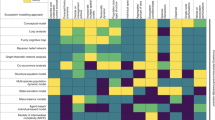Abstract
The most important components of ecosystems are the biological components, and a full environmental impact assessment of ecosystems will therefore require that these components are seriously considered. It is, for instance, not sufficient to assess the water quality by use of physicochemical parameters, although their determination can be carried out much more rapidly. There exists, in general, a relation between species composition and water quality.
Access this chapter
Tax calculation will be finalised at checkout
Purchases are for personal use only
Preview
Unable to display preview. Download preview PDF.
Similar content being viewed by others
References
Fontaine, T. D. (1981). A selfdesigning model for testing hypotheses of ecosystem development. In Progress in ecological engineering and management by mathematical modelling, ed. D. M. Dubois, Liège University, Liège, 620 pp.
Hynes, H. B. N. (1960). The biology of polluted water. Liverpool, Liverpool University Press.
Hynes, H. B. N. (1971). Ecology of running water. Liverpool, Liverpool University Press.
Hørnslet, E. (1988). Trophic characterization of lakes by means of qualitative phytoplankton analysis. Limnologica, 13, 249–261.
Jørgensen, S. E. (1981). A holistic approach to ecological modelling by application of thermodynamics. In Systems and energy, ed. W. Mitsch, R. K. Ragade, R. W. Bosserman and J. A. Dillon, Jr. Ann Arbor, Ann Arbor Science.
Jørgensen, S. E. (1986). Structural dynamic models. Ecol. Modelling, 31, 1–9.
Jørgensen, S. E. (1988). Use of models as experimental tool to show that structural changes are accompanied by increased exergy. Ecol. Modelling, 41, 117–126.
Jørgensen, S. E. (1988b). Fundamentals of ecological modelling, Elsevier, Amsterdam, 396 pp.
Jørgensen, S. E. (1991). Development of models, which are able to account for changes in species composition. Ecol. Modelling, (1991) in print.
Jørgensen, S. E., Nors-Nielsen, S. and Jørgensen, L. A. (1991). Handbook of ecological parameters and ecotoxicology. Amsterdam, Elsevier.
Straskraba, M. (1980). Cybernetic categories of ecosystem dynamics. ISEM. J., 2, 81–86.
Watanabe, M. (1983). The modelling of red tide blooms. In Application of ecological modelling in environmental management, Part A, ed. S. E. Jørgensen. Amsterdam, Elsevier.
Author information
Authors and Affiliations
Editor information
Editors and Affiliations
Rights and permissions
Copyright information
© 1992 Springer Science+Business Media Dordrecht
About this chapter
Cite this chapter
Jørgensen, S.E. (1992). Ecological Indicators and Ecological Modelling. In: McKenzie, D.H., Hyatt, D.E., McDonald, V.J. (eds) Ecological Indicators. Springer, Boston, MA. https://doi.org/10.1007/978-1-4615-4659-7_14
Download citation
DOI: https://doi.org/10.1007/978-1-4615-4659-7_14
Publisher Name: Springer, Boston, MA
Print ISBN: 978-1-4613-7108-3
Online ISBN: 978-1-4615-4659-7
eBook Packages: Springer Book Archive




